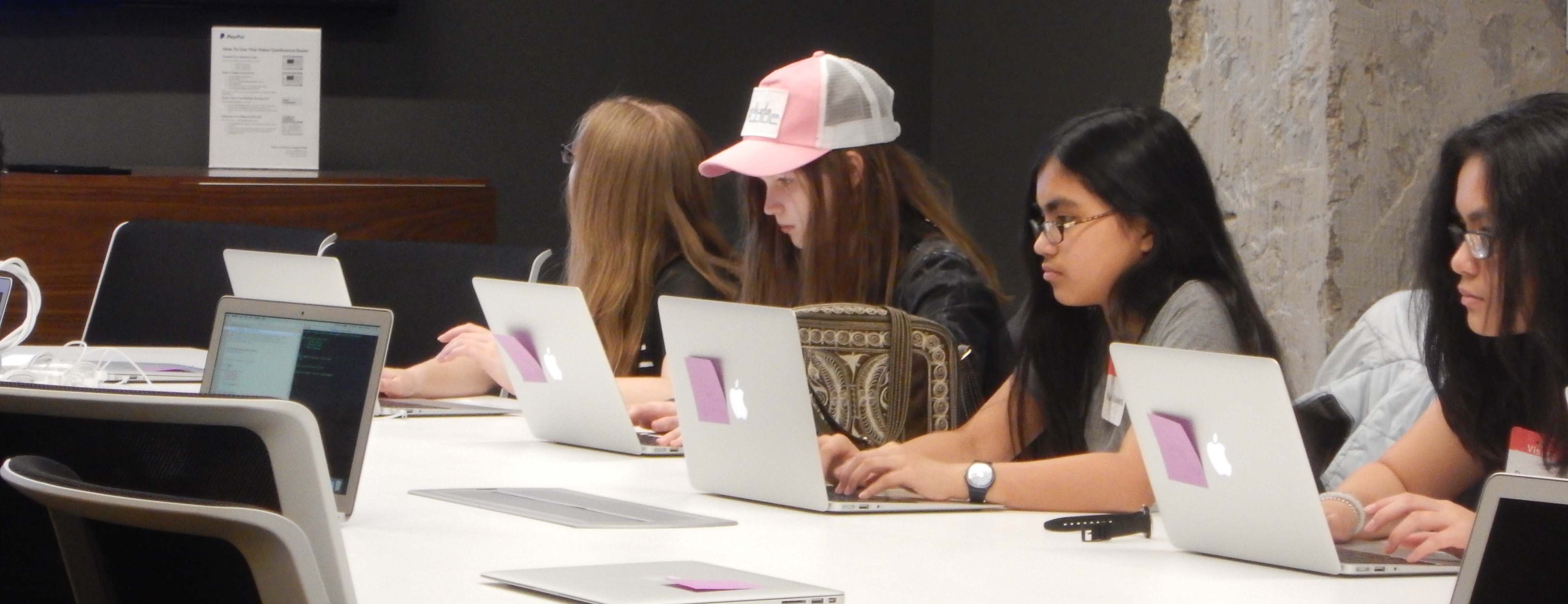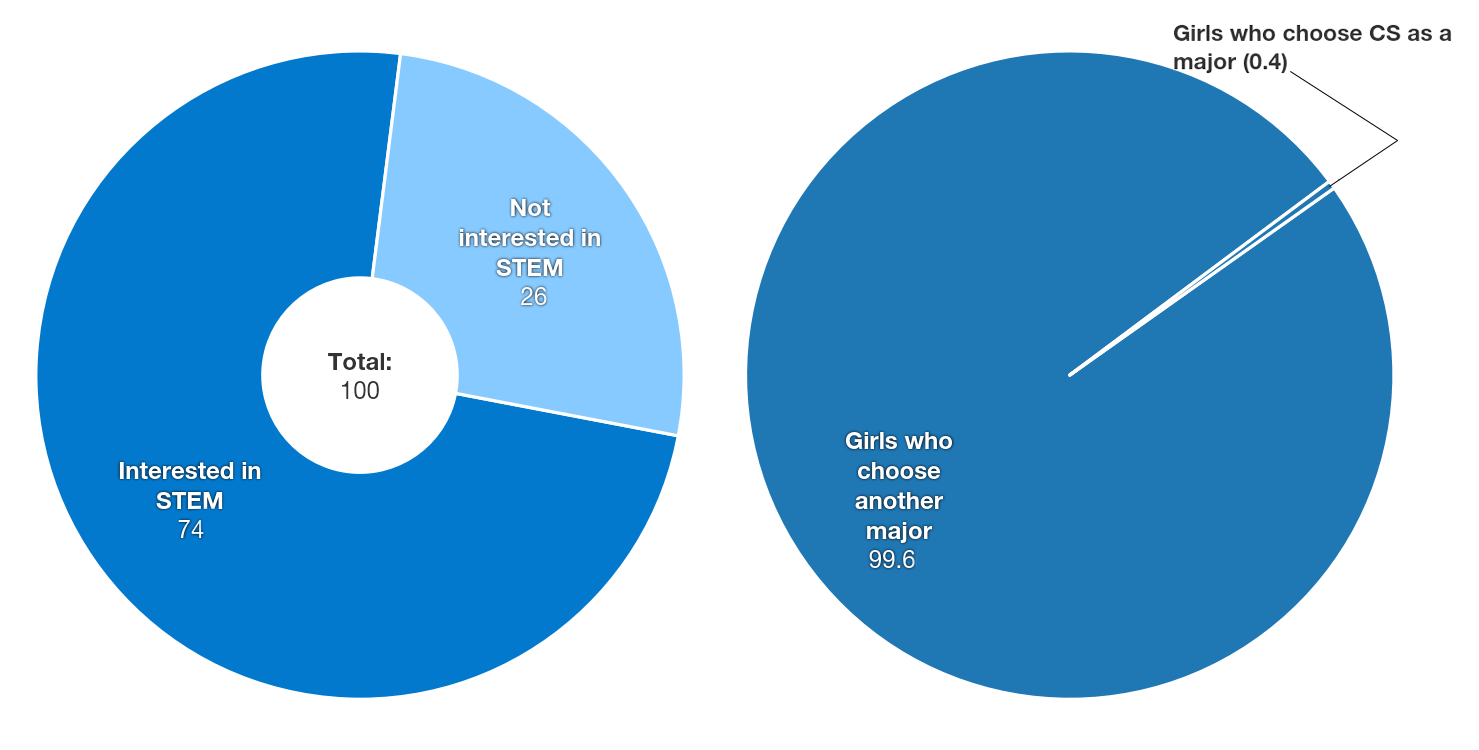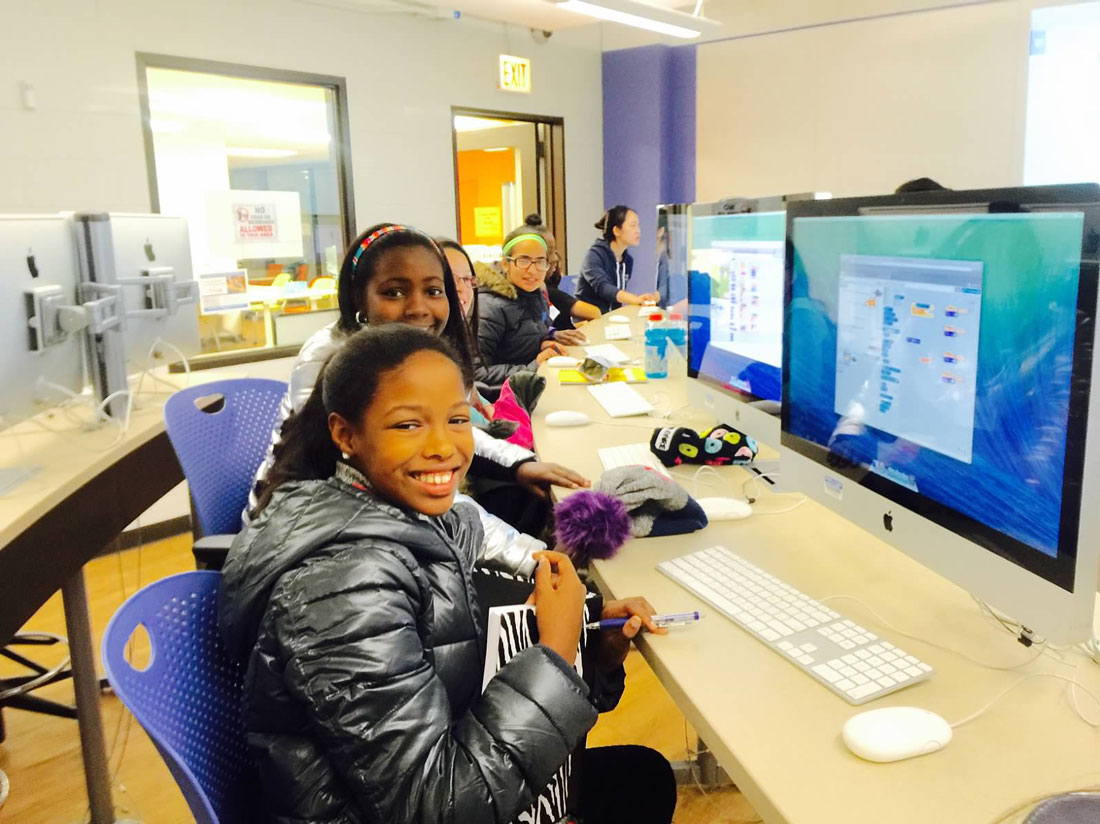By Lucia Maffei
“You know, first prize is $10,000. It could be the first share of your college tuition.”
The 10-something girl with a cat ear headband sits at a computer desk at DePaul University’s downtown campus. Two friends of hers work side by side.
It’s Saturday morning and every Saturday, Nancy and her friends Isa and Marissa attend the Girls Who Code club with 14 other young girls and six volunteer instructors and mentors. They log into the computers by using a special account created by the university and they start coding with Scratch, a free programming language designed especially for ages 8 to 16.
During the weekly meetings, they created an app that connects people who need clean water with people who can provide it. By the end of the month, the fully-functional app – now available on Google Play – will enter in a global competition called Technovation Challenge, giving Nancy, Isa and Marissa the chance to win the $10,000 prize.
A dynamic 47-year-old woman with black hair and a black fanny pack gives the group the tip about the $10,000 prize. She’s Lily Gulik, a sales manager for Oracle, and one of the mentors of the girls who strongly advocated for their participation in the challenge. When it comes to personal funding through accomplishments in computer science, Gulik knows what she is talking about.
As the eighth of nine children, Gulik never supposed she’d go to college. But she quickly realized that her talent for computer science could be her golden ticket to make a lot of money. And she jumped on it.
At age 14, she was hired by telecom corporation AT&T because of the software she had invented – a program creating reports for billing. The offer led to a paid internship at the company, which gave her the opportunity to learn more about computer science. And that led to a scholarship from Amoco Foundation, known today as BP Foundation, to attend DePaul University, where she graduated with a major in computer science.
Every Saturday, she arrives at DePaul from Albany Park at 9:00 a.m. and for two hours she teaches Scratch to middle school-aged girls. Then, she goes to the University of Illinois at Chicago, where she teaches the advanced session in the afternoon.

Gulik founded three local clubs of the national non-profit association Girls Who Code because she wanted to help other girls to learn computer science. “If I was selfish, I’d help only my kids,” she said, referring to Jasmine, 13, and Giselle, 11, who both attend the DePaul club.
The goal of Girls Who Code is closing the gender gap in the technology and engineering sectors by teaching 6th to 12th-grade girls – and only girls – how to code. During Level One, girls learn basic concepts of computer science such as data types and loops by programming in Python. At Level Two, they learn web development, which mostly means using tools such as HTML, CSS and JavaScript. By the time they start Level Three, they’re ready for 3D graphics and mobile development.
Some may ask why the opportunity to learn how to code for free isn’t granted to boys as well. But mentors – both women and men – don’t see it that way.
“The core mission is helping with gender inequality,” said Gulik, referring to the gender gap in tech-related jobs. “We’re in a mission to solve a problem, and there’s no need to argue that there’s a problem, because numbers tell us there is.”
Girls Who Code reported that 74 percent of middle school girls express interest in Science, Technology, Engineering and Math, the so-called STEM fields. But, when choosing a college major, just 0.4 percent of high school girls select computer science.
Number of middle school girls interested in STEM compared to high school girls who choose computer science as a college major (in percentage)

Why does this happen?
“It’s seen as a ‘boys club’,” said Kyle Wong, 27, a graduate student in computer science at DePaul who joined Girls Who Code as a mentor two months ago. Nevertheless, many women have made significant contributions to the field. “Take, for example, Margaret Hamilton. No one remembers who she is, but she wrote the code for the Apollo space program. Instead, everybody knows about Bill Gates.”

Wong pointed out that there are not many girls who are students in his classes. The majority of the girls are from China and India.
The gender gap starts before graduate school, though. Fiona Baenzinger, an 18-year-old freshman at DePaul, said she counts five girls out of 40 students in her first-year mathematics class, and six girls out of 20 in her Python coding language class, where the instructor is a woman. “In the higher classes, we’re going to see more men as teachers,” she pointed out.
Her forecast is plausible. According to Associate Dean Theresa Steinbach, among 58 full-time faculties in the School of Computing at DePaul, 24 percent are women. “It’s a good rate,” Steinbach said.
Coming back to the point of view of students, Baenzinger also reported that many of her friends – girls – dropped the science-related classes.
“Learning in a male-dominated environment can be intimidating,” said Baenzinger, a Naperville-native who joined Girls Who Code as a mentor in October 2015. “There’s simply the assumption that boys are more comfortable, so everything is targeted to them. For example, nobody wants to work with a girl on group projects. That’s why saying to girls ‘You can do it’ is so important.”
Chicago ranks third in the U.S. in the number of Girls Who Code clubs, after New York and San Francisco. New York, the city where Girls Who Code was officially born as a formal association in 2012, counts today 79 clubs. San Francisco, where an above average number of people master the skills to teach coding because of the proximity of Silicon Valley, counts 20 clubs. But Chicago could do a better job at teaching girls coding, said Gulik, who founded three of a total of 14 clubs. “It’s like a Lily Show, and it really shouldn’t be,” she said. “In the Chicago area, there are only four club organizers.”
Number of Girls Who Code clubs by city (only cities with more than one club)
[field name=”clubsbycity”]
Founder and CEO of Girls Who Code Reshma Saujani graduated in political science at the University of Illinois at Urbana-Champaign. Then, after completing Yale Law School, Saujani decided to start Girls Who Code because she saw the gender gap in a computing class firsthand in 2010, during her race as the first Indian-American woman to run for U.S. Congress.
In slightly more than five years, the association has gone from a membership of 20 girls in New York to more than 10,000 girls in 42 states, according to the 2015 annual report. Clubs report that 65 percent of participants said they were considering a major or a minor in computer science because of their experience at Girls Who Code.
By the end of 2016, Girls Who Code plans to reach more than 40,000 girls in every state through weekly club meetings and seven-week long summer immersion camps. Parents can sign up their daughters by checking the Girls Who Code website and looking for the program they are interested in. Regular clubs meet once a week during school year; summer camps meet five days a week between June and July. They are both free, but parents need to provide transportation.
“We had more requests than we were able to accommodate,” said Sonika Anand, 29, a web developer, referring to the 40-spots in the summer program that will be starting in June at the University of Illinois at Chicago. The regular club had 20 students enrolled in 2014. The following year, the enrollment tripled to 60 students. “Even though it’s a free program, parents take it seriously,” she added.
A native of Indore, in central India, Anand arrived in the U.S. in 2009 to pursue a master’s degree in electrical and computing engineering at UIC, after having graduated in computer science at Rajeev Ghandi University. She learned the programming language C++ during high school, but she had been interested in computer science since 5th grade, when teachers explained two other programming languages called Basic and Logo.
“I could do something and it worked,” Anand remembered. “That got me really interested in computer science.”
But during middle school, she had nobody to guide her. And she said she was afraid to speak up in class. If she gave the wrong answer, she figured classmates would make fun of her.
“Having a support group gives girls a place to feel comfortable and gain confidence,” said Steinbach, associate dean of DePaul’s College of Computing and Digital Media. She is also a teacher for Girls Who Code. “As a result, they can become a more confident member of other coding communities that include boys. We also try to expose girls to companies, speakers, challenges, role models and career opportunities.”
Speaking of career planning, the U.S. Department of Labor projects that by 2020, there will be 1.4 million computer specialist job openings. Not every job position related to tech, however, needs professional programmers. “It’s a common misunderstanding,” said Jeff Glidden, 35, Girls Who Code mentor since February 2016. “You can be a project manager, do quality assurance testing or business analysis.”
Projected percent growth in employment in selected occupations in computer related services, 2014-2024
[field name=”careers”]
Glidden, a North Side resident, studied computer information systems and business before becoming the tech program manager at JPMorgan Chase & Co. He sees the gender gap in his workplace, he said. “There are way more men. The proportion is 60-40 in a good day, and 80-20 in a bad day.”
Boys have plenty of opportunities to learn to code, said Jeff Ring, 51, another mentor. His tone is conclusive: “If boys want to code, great.” Meaning, boys don’t need to attend Girls Who Code clubs.
“There are millions of technology-related jobs, and not enough girls to fill that positions,” said Anand. “We really need to get girls excited about science.”


